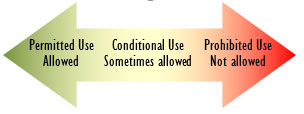Permitted and Prohibited Uses
Permitted Uses

Each zoning district must provide for permitted uses that are allowed by right throughout the district. An example would be single-family or multi-family homes in a residential district.1 Permitted uses are authorized by the zoning administrator with a simple permit. Authorization must be granted if the project complies with general standards for the zoning district, any overlay district or design standards, and related building or construction codes.
Some ordinances list uses that are expressly prohibited for a particular district. Uses that are not specifically listed are also prohibited.2 If the permitted uses in a zoning ordinance do not allow the use sought by a landowner, they may seek special review of the situation through a conditional use, variance or zoning amendment.
Conditional Uses
Conditional uses may also be listed for each district in a zoning ordinance. A conditional use allows a landowner to put a property to a use which the ordinance expressly permits when specified standards have been met.3 An example is a daycare facility in a residential district that is allowed subject to parking, fencing and signage requirements.
The decision to grant or deny a conditional use is discretionary and is determined by whether the applicant can meet the conditional use standards contained in the ordinance. Generally, a conditional use must be compatible with neighboring land uses, tailored to meet the limitations of the site, and may not be in violation of the ordinance objectives. If a conditional use permit is granted, conditions may be attached to mitigate potential negative impacts associated with the development. The zoning ordinance should assign review of conditional uses to the governing body, plan commission, or zoning board of adjustment or appeals.
Watch Now: Types of Zoning Decisions
An introduction to permitted use, conditional use and prohibited use decisions.
Footnotes
2Foresight, Inc. v. Babl, 211 Wis. 2nd 599, 565 N.W.2d 279 (Ct. App. 1997).
3State ex. rel. Skelly Oil Co., Inc. v. City of Delafield, 58 Wis. 2d 695, 207 N.W.2d 585 (1973).




